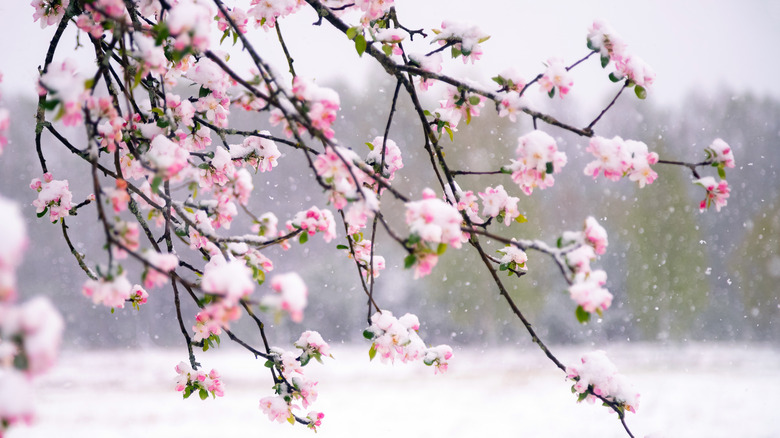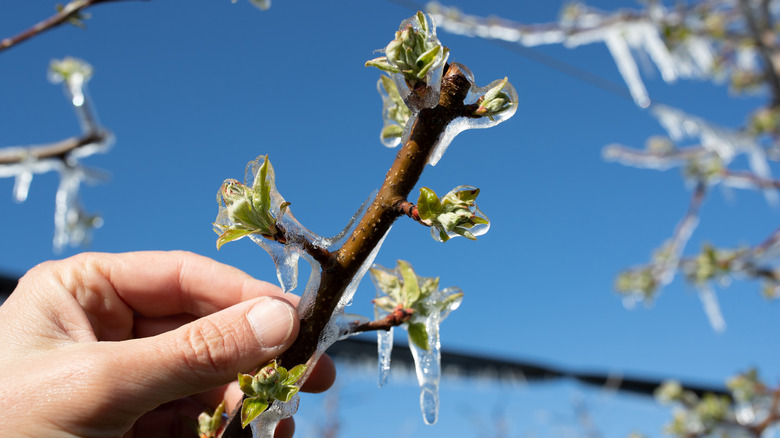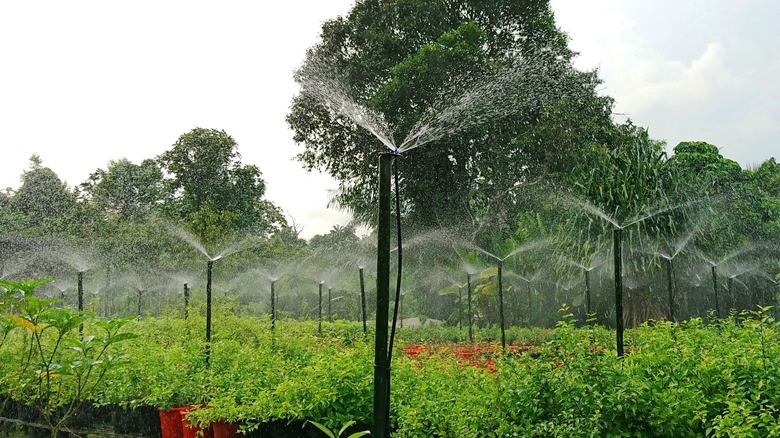The Unexpected Way Water Can Protect Your Fruit Trees Before A Late Freeze
During winter, fruit trees enter a period of dormancy. Warmer weather signals them to emerge from hibernation and produce buds, which will grow into flowers and eventually fruit. But these buds and blooms are susceptible to freezing temperatures, so a spring frost can damage them and hinder your fruit tree harvest. If your tree has already grown buds, you'll need to protect it from late freezes to enjoy delicious produce later. One surprising way to do this is to cover your tree in a continuous spray of water during the freeze.
How cold is too cold for your fruit tree? It depends on the species and the stage of bud development. Buds become increasingly vulnerable to cold as they grow and turn into flowers. The "critical temperature" is the temperature at which your tree will be injured; you can look this up at places like PennState Extension to determine whether a coming frost is a threat. For example, apple tree buds in the earliest stage of development are at risk only if the temperature dips below 15 degrees Fahrenheit — but once these buds are in full bloom, anything below 28 degrees can hurt them. Keeping an eye on your tree's bud growth and the weather forecast is key to protecting it from a late freeze. You can't reverse frost damage, but you can prevent it.
How watering can protect your fruit tree
Farmers have learned several ways to protect fruit trees from late freezes. Some of these, like wind machines and helicopters, are designed for large-scale crops and aren't feasible for home use. Covering trees with cloth to trap warm air and placing small heaters nearby are popular methods for home growers, but they can be hard to implement on large trees. Another option is an over-tree sprinkler, which sprays water over the tree and coats it in a layer of ice. This may seem counter-intuitive, but actually works — as long as you do it right.
When water changes from a liquid to a solid, it releases heat, which you can harness to protect your tree from the cold. If you give your tree a steady flow of water, the water will continuously freeze and keep the tree warm. As long as the ice layer on the tree stays wet, it will remain at 32 degrees Fahrenheit. But if the flow of water stops, the ice will start to evaporate and harm the tree. While freezing water releases heat, evaporating ice causes your fruit tree to get colder than the air around it, thus resulting in even more damage. That's why you want to continually water your tree during the frost. You also want the ice to always appear clear and not cloudy, as that would be an indicator that heat is being released from the tree.
How to water when a freeze is in the forecast
To implement the over-tree watering method on a fruit tree in your backyard, you'll need to install an overhead sprinkler. You can attach a sprinkler head to a pole or place a sprinkler on a ladder — just make sure it's set to move continuously and cover all the branches. The key is to water nonstop, from before the air reaches critical temperatures until the freeze lifts and the ice starts to melt.
The irrigation rate, or how fast water is applied, is crucial. As the temperature drops or the wind picks up, a higher irrigation rate will be needed to keep your tree safe. Depending on the expected weather conditions, you can look up the irrigation rate you'll need to maintain on websites like Michigan State University Extension. Because most sprinklers have a relatively-low rate, the over-tree watering method is only practical for freezes above about 24 degrees Fahrenheit.
Another downside to this method is that it uses a lot of water. This not only inflates your utility bill but can also cause problems in your garden after the freeze. The weight of the ice layer on your fruit tree may break some branches, and the roots can suffer from excess water pooling around the tree as the ice melts. If a freeze is expected to last several days or dip below 24 degrees Fahrenheit, consider protecting your fruit tree with a fabric covering or heater instead.


